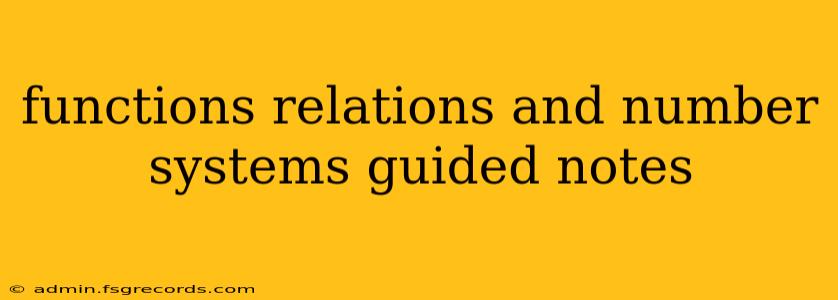Understanding functions, relations, and number systems is fundamental to success in higher-level mathematics. This guide provides a structured overview, perfect for students needing a concise yet comprehensive resource. We'll explore key concepts, definitions, and examples to solidify your understanding.
I. Number Systems
Mathematics begins with numbers. Let's review the major number systems:
A. Natural Numbers (N)
- Definition: These are the counting numbers: 1, 2, 3, 4, ... They're used for counting objects.
- Key Characteristics: Positive integers, infinite set.
B. Whole Numbers (W)
- Definition: Includes natural numbers and zero: 0, 1, 2, 3, 4, ...
- Key Characteristics: Non-negative integers, infinite set.
C. Integers (Z)
- Definition: Includes whole numbers and their negatives: ..., -3, -2, -1, 0, 1, 2, 3, ...
- Key Characteristics: Positive, negative, and zero; infinite set.
D. Rational Numbers (Q)
- Definition: Numbers that can be expressed as a fraction p/q, where p and q are integers, and q ≠ 0. This includes terminating and repeating decimals.
- Examples: 1/2, -3/4, 0.75 (which is 3/4), 0.333... (which is 1/3).
- Key Characteristics: Can be represented as a ratio of two integers.
E. Irrational Numbers (I)
- Definition: Numbers that cannot be expressed as a fraction p/q, where p and q are integers, and q ≠ 0. Their decimal representations are non-terminating and non-repeating.
- Examples: π (pi), √2, e (Euler's number).
- Key Characteristics: Cannot be represented as a simple fraction.
F. Real Numbers (R)
- Definition: The union of rational and irrational numbers. This encompasses all numbers on the number line.
- Key Characteristics: Includes all rational and irrational numbers.
G. Complex Numbers (C)
- Definition: Numbers of the form a + bi, where 'a' and 'b' are real numbers, and 'i' is the imaginary unit (√-1).
- Examples: 2 + 3i, -1 - i, 5i.
- Key Characteristics: Extends the real number system to include imaginary numbers.
II. Relations
A relation is simply a set of ordered pairs. These pairs show a connection or relationship between elements from two sets (often, but not always, the same set).
- Example: The relation "is taller than" between people in a class. If person A is taller than person B, we could represent this as an ordered pair (A, B).
Relations can be represented in various ways:
- Sets of ordered pairs: {(1, 2), (3, 4), (5, 6)}
- Tables:
| Input | Output |
|---|---|
| 1 | 2 |
| 3 | 4 |
| 5 | 6 |
- Graphs: Plotting the ordered pairs on a coordinate plane.
III. Functions
A function is a special type of relation where each input (x-value) corresponds to exactly one output (y-value). This is the crucial difference between a relation and a function.
- The Vertical Line Test: A graphical way to check if a relation is a function. If any vertical line intersects the graph more than once, it's not a function.
Key Function Terminology:
- Domain: The set of all possible input values (x-values).
- Range: The set of all possible output values (y-values).
- Independent Variable: The input variable (usually x).
- Dependent Variable: The output variable (usually y).
A. Function Notation
Functions are often written using function notation: f(x) = ... This means "the function f applied to x." For example, if f(x) = 2x + 1, then f(3) = 2(3) + 1 = 7.
B. Types of Functions
There are many types of functions, including:
- Linear Functions: f(x) = mx + b (straight lines)
- Quadratic Functions: f(x) = ax² + bx + c (parabolas)
- Polynomial Functions: Functions involving powers of x.
- Exponential Functions: Functions where the variable is in the exponent.
- Trigonometric Functions: Functions involving angles (sine, cosine, tangent, etc.).
This guide provides a foundational understanding of number systems, relations, and functions. Further exploration of specific function types and their properties will build upon this base. Remember to practice problem-solving to reinforce your learning!

